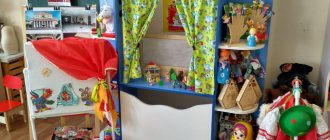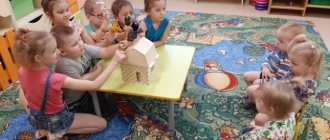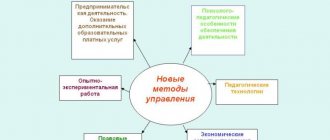Relevance, purpose and objectives of theatrical activities in preschool education.
Theatrical activity is a source of development of feelings, deep experiences of the child, and introduces him to spiritual values. It is equally important that theatrical games develop the emotional sphere and make one sympathize with the characters. Theatrical activities permeate all routine and educational moments.
The basis of this work lies in the use of nursery rhymes, sayings, jokes, and lullabies. Oral folk art, presented in the form of skits and dramatization games, creates an atmosphere of warmth, kindness, attention, and contributes to the formation of an emotionally positive attitude of children to the world around them and their cognitive development.
Theatrical activities develop the child’s personality, instill a sustainable interest in literature and theater, improve children’s artistic skills in terms of experiencing and embodying an image, and encourage them to create new images.
Thanks to this form of work, communication with children becomes more interesting and meaningful. It is no secret that young children perceive speech addressed to them better if it is supported by visual objects (pictures, toys).
During development, changes occur in the emotional sphere of the child. His views on the world and relationships with others change. The child's ability to recognize and control his emotions increases. But the emotional sphere itself does not develop qualitatively. It needs to be developed.
Being confined to televisions and computers, children began to communicate less with adults and peers, but communication greatly enriches the sensory sphere. Children today have become less responsive to the feelings of others
Theatrical activities in kindergarten can organizationally permeate all routine moments: be included in all classes, in the joint activities of children and adults in their free time, and carried out in children’s independent activities. Theatrical activities can be organically included in the work of various studios and clubs; products of theatrical activities (stage plays, dramatizations, performances, concerts, etc.) can be included in the content of holidays and entertainment.
Thus, theatrical activity is the most important means of developing in children the ability to recognize a person’s emotional state by facial expressions, gestures, intonation, the ability to put oneself in his place in various situations, and find adequate ways to help. Theatrical activities make it possible to develop the experience of social behavioral skills due to the fact that every literary work or fairy tale for preschool children always has a moral orientation (friendship, kindness, honesty, courage, and others). Theatrical activities are a source of development of feelings, deep experiences and discoveries of the child, introducing him to spiritual values. Theater reveals the spiritual and creative potential of the child and provides a real opportunity to adapt to the social environment.
From puppet theater in kindergarten to understanding oneself in the world around us
Bibliographic description:
Chekanova, O. L. From puppet theater in kindergarten to knowing oneself in the world around us / O. L. Chekanova.
— Text: direct // Theory and practice of education in the modern world: materials of the I International. scientific conf. (St. Petersburg, February 2012). - T. 1. - St. Petersburg: Renome, 2012. - P. 136-137. — URL: https://moluch.ru/conf/ped/archive/21/1514/ (access date: 02/05/2022). Puppet theater is the most common form of organizing children's leisure in kindergarten. Puppet shows enjoy the well-deserved love of children and bring great pleasure to the organizers of the productions. The doll itself is very close to children’s perception, because they have been familiar with this toy since early childhood, and therefore perceive it as a close friend. And if this hitherto silent friend unexpectedly comes to life before their eyes, tells stories, sings, laughs and cries - this spectacle turns into a real holiday for them.
However, puppet theater cannot be considered only as entertainment. Its educational and cognitive significance is very important. During the preschool period, the child begins to develop an attitude towards the environment, character, and interests. It is at this age that it is very useful to show children examples of friendship, kindness, truthfulness, and hard work.
Puppet theater is a synthetic art; it influences young spectators with a whole range of artistic means. When showing puppet theater performances, both the artistic word and a visual image - a doll, and picturesque and decorative design, and music - a song, musical accompaniment are used. The skillful use of puppet theater provides great assistance in the daily work of a kindergarten in the mental, moral, and aesthetic education of preschoolers.
The role of puppet theater in the development of a preschool child cannot be overestimated. First of all, a doll helps to establish contact with a child if he is “enslaved,” emotionally “stressed,” or afraid of strangers. A small doll causes less fear and apprehension, and a child, especially a younger one, makes contact with it faster than with an adult. Children who avoid touching are more likely to give a hand and say hello to a doll than to a teacher. By actively interacting with the doll, the child gradually becomes more open and courageous in direct contacts with the outside world, with people. This allows a preschool child to most painlessly go through the period of adaptation to school, new teachers, curriculum, and often to a new children's team.
Familiarization with playing dolls begins at an early age. Putting a doll on his hand - a kitten, a dog, a parsley, the adult sings (melodic sounds attract the baby's attention) a nursery rhyme, a song, a joke, imitates the voices of different animals, evokes a positive emotional reaction in the child, which in turn contributes to the early formation of aesthetic taste in the child, emotional creative needs.
In younger groups, poems, fairy tales, and songs familiar to children are acted out using a table theater. The fairy tale "Turnip", for example, is illustrated using plane dolls. And with the cheerful Petrushka, who is not even hiding behind a screen, the children willingly shake hands and answer his questions.
With children of the third and fourth year of life, they act out the simplest plots of familiar fairy tales, using elements of costumes and hats with silhouettes of characters. The children willingly join in the dramatization of the fairy tale using a flannelgraph, tabletop and finger theater.
Children of the fifth and sixth year of life, as a rule, already know and love puppet theater and participate with great desire in performances. The teacher is faced with the task of encouraging preschoolers to engage in independent theatrical games and to dramatize familiar literary works. Children of this age can already be taught to drive dolls - parsleys and puppets.
By mediating interaction with other people with dolls, timid children begin to understand the process of communicating with peers. By playing the roles of characters with different personalities, children “try on” different models of social behavior. By playing the role of a Wolf or a Bear, a child can express aggression, by playing the role of a Bunny - caution, by playing the role of a Cockerel - determination and courage. This experience allows the child to subsequently show tolerance, perseverance, and kindness in various life situations.
For a child, a puppet theater character is, first of all, a toy. The child sees how performances are performed with the help of dolls and begins to understand that they were created in order to “retell” the content of the fairy tale. Around middle preschool age, the child himself, without the help of dolls, tries to repeat and act out a familiar fairy tale. Active children always enjoy playing roles: putting on costumes, speaking and acting. But for many children, getting on stage is a serious test. It’s often the first time a child dares to speak words from the stage on behalf of a doll. He psychologically hides behind the doll.
In the hands of an adult, a doll is an assistant in solving many pedagogical problems. With the help of a doll, you can create playful motivation for the productive activities of children, give an adequate assessment on behalf of the doll of the product of the child’s activity without the risk of causing his resentment or resistance. This use of characters is most effective when working with children of middle and primary preschool age.
Both adults and children can participate in the puppet show. Such activities enrich children with new impressions, knowledge and skills, develop interest in literature, music, theatrical art, and form aesthetic taste. This is a great opportunity for teachers to carry out various educational, educational, and moral tasks not in an edifying way, but directly, unnoticeably for children, who, as a rule, are captivated by theatrical performances.
Music in puppet shows sounds during the plot, when the characters sing, dance or simply listen to the playing of the violin, piano, harmonica, pipe, etc. Music is introduced to create a certain mood, as a musical setting. However, in a puppet show it is not always of an auxiliary nature. Music often plays a very important role. How long will the attention of a preschool child last if he sits motionless on a chair during a theatrical performance? No more than 10 minutes. What if he takes an active part in the performance, for example, performing as a spectator some piece of music that is especially important for the successful continuation of the performance? This number doubles (sometimes triples)! At the same time, children’s emotional responsiveness, choral singing and children’s performance skills are formed (it’s one thing to sing for the audience, and quite another for the artists themselves!).
The musical repertoire for such performances is prepared with the children in advance during music classes, and the children do not necessarily know where they will use it. This will help maintain the moment of surprise.
The saturation of the performances with emotional and entertaining moments also increases the interest of children. The collective empathy of children forms in them the rudiments of social feelings and relationships.
Performances involving a puppet theater will occupy a certain place in the kindergarten system, provided:
— the presence and development of children’s ideas and interest in various types of theater;
— children mastering the rules and techniques of theatrical activities;
- a serious, sincere, emotionally positive attitude of the teacher towards children’s theater games.
Staging a puppet show with the participation of children is a very labor-intensive task, requiring great emotional investment and creative energy of both the directors and the actors themselves - the children. It is very important to take into account several psychological factors. The process of identifying, detecting the emotions of some children, when it occurs in the presence of the whole group, is necessary not only for the teacher, who uses it as a condition for changing the inappropriate position of the child; This process helps preschoolers understand each other, focus on the strengths and weaknesses of their peers’ character, and understand their experiences. An atmosphere of deep mutual understanding is a fertile ground for eliminating unethical, selfish tendencies in children, cultivating responsiveness, sensitivity to good and intransigence to evil. The means of influencing children’s feelings are: purposeful interaction with morally contradictory characters, the sincere, emotionally expressed attitude of the teacher himself to all moments of a fairy tale or role-playing game, and, finally, the active position of sensitive, responsive children, of whom there are always many in the group.
At first, it is very difficult for a teacher to organize such performances; the ability to quickly and creatively respond to the emotional responses of both actors and spectators, to clearly navigate difficult moments and to direct the entire performance absolutely imperceptibly does not immediately develop. But when this skill comes, working on staging the play gives great pleasure not only to the children, but also to the adults participating in it.
Key terms
(automatically generated)
: puppet theater, child, kindergarten, doll, puppet show, doll face, music, teacher, puppet help, aesthetic taste.
Theatrical and gaming activities
The spiritual life of a child is complete only when he lives in the world of fairy tales, creativity, imagination, fantasy, and without this he is a dried flower.
V. Sukhomlinsky
The relevance of theatrical and gaming activities at the present stage is obvious: pedagogy from “didactic becomes developmental”, which means the use of elements of theatricalization and improvisation in the process of teaching and raising children is becoming more and more noticeable, representing one of the promising directions of pedagogical thought. Getting acquainted with modern ideas of developmental education, we understood their essence for ourselves, trying to adhere to its main principles of development, creativity, and play. We support those pedagogical ideas and the essence of which boils down to a single concept: the development of a child can be understood as an active process of self-awareness, the active creation of a biography by a little person. And adults must help him - teachers in this case - We, musical directors, connected with him by common ties of assistance and cooperation.
In our activities, we rely on the works of such authors as Vygotsky A. S. “Imagination and creativity in childhood” - M., Prosveshchenie, 1991., Voronova V. Ya. “Creative games of older preschoolers” - M., Prosveshchenie, 1971., Fesyukova L. B. “Education with a fairy tale” - Enlightenment, 1990., Kazakova T. G. “Develop creativity in preschoolers” - M., Education, 1985., Sinitsyna K. S. “Clever fairy tales” - M. , Education, 1997., program “Musical Masterpieces” Radynova O., “Musical Development of Children” Radynova O., Antipina A. E. “Theatrical Activities in Kindergarten”, Burenina A., “Theater of All Possible”.
We use the total pedagogical ideas of these authors in the following context. The path to becoming a creative personality is difficult and complex. From the first spark of independent thought to the need to think, think, reason, there is a long way to go. The pace of this journey is different for each child. It is important to be patient, not to rush, not to rush, not to rush to give ready-made solutions, not to “feed” the child with chewed “spiritual food”. Everyone knows the truth: “Coercion is the enemy of creativity.” Creative development is possible only if the child has positive motivation. Therefore, an important point in the process of organizing developmental activities in kindergarten is the creation of motivation, which is based on the basic needs of preschool children.
Psychologists note that it is in play that a preschooler’s need to act independently as an adult is realized.
Theatrical games provide great scope for the child’s creative expression. They develop children’s creative independence, encourage improvisation in composing short stories and fairy tales, and support children’s desire to independently seek expressive means to create an image, using movements, posture, facial expressions, different intonation and gesture. In order for a child to show creativity, it is necessary to enrich his life experience with vivid artistic impressions and give him the necessary skills and knowledge. The richer the child’s experience, the brighter the creative manifestations in various activities. Therefore, it is very important to introduce a child to music and theater from a very early age. To captivate children with art and teach them to understand beauty is the main mission of a music director. It is art (theater) that awakens in a child the ability to think about the world, about himself, about responsibility for his actions.
In our opinion, theatrical and play activities are a vivid emotional means that shapes the aesthetic taste of children. Theater influences the child’s imagination through various means: words, actions, visual arts, music.
First of all, in our kindergarten, the teachers created conditions for the theatrical and playful activities of children: they purchased a puppet theater, together with the teachers they made shadow and finger theaters, and made a screen with a curtain for changing the scenery during the performance.
We constantly replenish the set of musical instruments: metallophones, xylophones, tambourines, triangles, harps, rattles, etc. With the help of our parents, we prepare costumes for fairy tales.
We involve children in theatrical and play activities, starting from early preschool age. Thus, in the younger group, together with children from the preparatory school group, they staged a musical performance based on the Russian folk tale “Zayushkina’s Hut.” Kids are spectators, but at the same time they are also performers of individual numbers (girls perform the flower dance, boys perform the hare dance). Throughout the musical performance, child actors conduct a dialogue with the children-spectators. For example, Lisa asks the children: “Whose hut was it?” The audience answers: “Zayushkin.” And so on.
In the middle group we continue to enrich children's experiences and develop their gaming skills. It was a successful evening of fairy tales and riddles, in which children from the secondary and preparatory school groups took part. Children in their fifth year of life played independently in the orchestra and behaved more freely in the hall. In the script for matinees and evenings of entertainment for the older group, we include short fairy tales and dramatizations. Most often the action takes place in the forest, and the characters are children. For example, the script for the New Year's matinee included the staging of "The Magic Boot", and the script for the matinee dedicated to International Women's Day on March 8 included the staging of "Snowdrops". Such creative activity of children at entertainment evenings and matinees leads them to stage children's operas in the preparatory group for school.
Older preschoolers will remember a visit to the theater for a long time. After watching the performance, the actors talked with the children, showed them techniques for working with dolls, and answered numerous questions from the children: “How do they make dolls for the theater?”, “Who can become an artist?” and so on.
After such excursions to the theater, children’s games become noticeably livelier, becoming more varied and emotional.
For the production of children's operas, the choice of literary work that forms the basis of the libretto is of great importance. We choose a literary work together with teachers, taking into account the knowledge and interests of the children.
Together with the teachers, we think in advance about how best to convey the content of the text and music to the children. We try to ensure that every child becomes interested in the fairy tale and expresses a desire to play one or another role in it. After reading the fairy tale, we suggest listening to it in audio recording. Then we have a conversation with the guys, with the help of which we teach them to delve into the essence of the characters’ behavior.
Next, we invite children to listen to the music to which each character acts. The children are transported to a fairy-tale world and experience various emotions and experiences. Then the teacher learns the text with the children, paying special attention to the expressiveness of speech.
In addition, we give the kids small tasks. For example, when preparing for an opera
We suggest running “Turnip” like a Bug or a Cat; pronounce the words in a thin voice, like a Mouse, or in a cheerful, ringing voice, like a Granddaughter. Many movements of individual and group dances, for example the dance of the Fly and the Mosquito in the opera “The Fly-Tsokotukha”, the dance of the snowdrops in “The Twelve Months”, were invented by the children.
When assigning roles, we take into account the individual abilities of children and their capabilities. We were worried about the question: what to do if not everyone who wants can get the role? We decided to appoint an understudy for each role. This gives inactive children the opportunity to overcome their shyness, take a closer look at their friend, and create a fairy-tale image in their own way. We give children in the pre-school group the opportunity to assign roles themselves. Usually the candidates nominated by children for the main roles coincide with our choice. But this skill did not come immediately, of course. Children were gradually taught to notice the abilities of their comrades: the ability to transform, to convey the characteristic abilities of literary characters in dramatizations.
Dramatization games for older preschoolers often become performances, and the spectators are children from other groups.
The kindergarten does a lot of work with parents: they set up a stand “Artistic creativity of children with color photographs, where you can see how children participate in artistic activities. We provide consultations for parents on the topics “Development of theatrical and play activities in children”, “Creating conditions for independent artistic creativity”, “The influence of theater on the formation of artistic taste in children”, etc.
The value and benefits of theatrical activities are obvious, since they are closely related to other types of activities - singing, moving to music, listening, etc.
In the process of work, children literally transform before our eyes, become free, liberated, and if they skillfully pose questions, they learn to think, analyze, and propose their own ideas. Our task as a teacher is to practice encouraging the child to “see, be surprised, tell.”
By working on the expressiveness of characters’ remarks and their own statements, children’s vocabulary is activated and the sound culture of speech is improved.
We believe that children's theatrical activities help us solve many pedagogical problems related to the formation of the expressiveness of a child's speech, intellectual and artistic-aesthetic education. Any fairy tale or theatrical play is an inexhaustible source of development of feelings, experiences and emotional discoveries, a way of becoming familiar with spiritual wealth.
It is very important for us as teachers that in a world saturated with information and new technologies, a child does not lose the ability to understand the world with his mind and heart, expressing his attitude towards good and evil, and can experience the joy associated with overcoming communication difficulties and self-doubt. The need for contact and systematization in a single pedagogical process is obvious.
Pedagogical project “Puppet Theater”
Elena Ugolnikova
Pedagogical project “Puppet Theater”
Problem: parents have insufficient understanding of the role of theatrical activities in the development of children’s speech and difficulty in children using puppet theater in independent creative activities.
Justification of the problem:
1. Insufficient attention of parents and children to puppet theater .
2. Children’s skills in “acting”
puppeteers.
Type of project : educational - creative, gaming.
Project participants : children of the middle group (4 – 5 years old)
“Fireflies”
, teachers, parents of group pupils.
By number - the whole group
Duration: November 2016, short-term.
Project goal : To introduce children to theatrical art and puppet theater . To promote the formation of a creative personality in a child; develop speech and communication skills in children. Create conditions for the development of children's creative activity in theatrical activities , provide conditions for interconnection with other types of activities in the holistic pedagogical process .
Project objectives :
1. Expand children's understanding of puppet theater , its types, attributes, costumes, and decorations.
2. Create conditions for organizing joint theatrical activities between children and adults, aimed at bringing children, parents and teachers .
3. To create an artistic and aesthetic, creatively developing subject environment in the preschool educational institution.
4. Teach children to establish and regulate contacts in joint and independent activities.
5. Develop emotionality and expressiveness of speech in preschoolers.
6. Instill in children primary skills in the field of theatrical art
(puppeteering, character dialogue)
.
7. Contribute to the formation of aesthetic taste.
8. Ensure interconnection with other types of activities: visual, musical, fiction, design.
9. Involve adults and children in theatrical and performing activities .
10. Involve parents in the theatrical and cultural life of preschool educational institutions .
Relevance of the project :
Theater , as one of the most accessible forms of art, helps to improve the general culture of the child and the formation of correct behavior in the modern world. At the same time, preschoolers can be both spectators of theatrical action and its participants. Theatrical activities , through performances - fairy tales, holidays, puppet shows or activities with elements of dramatization, allow children to build communication with each other. Children learn to look at themselves from the outside, depicting different characters, actions, and reveal the meaning of such concepts as friendship, kindness, honesty, courage, etc.
In theatrical activities, the child liberates himself, conveys his creative ideas, and receives satisfaction from the activity. Theatrical activities help to reveal the child’s personality, his individuality, and creative potential. The child has the opportunity to express his feelings, experiences, emotions, and resolve his internal conflicts.




